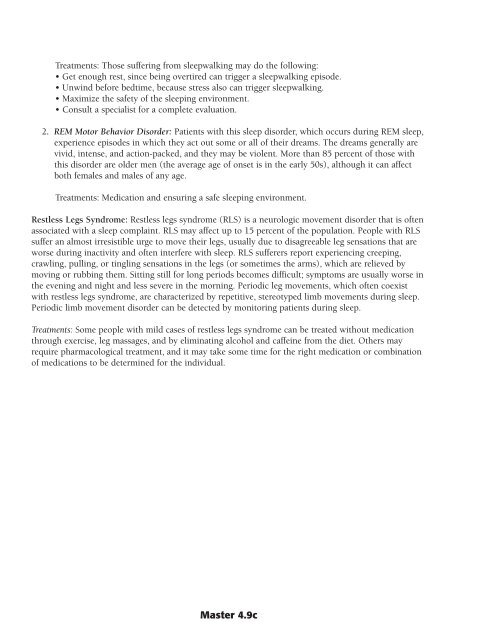Biological - NIH Office of Science Education - National Institutes of ...
Biological - NIH Office of Science Education - National Institutes of ...
Biological - NIH Office of Science Education - National Institutes of ...
You also want an ePaper? Increase the reach of your titles
YUMPU automatically turns print PDFs into web optimized ePapers that Google loves.
Treatments: Those suffering from sleepwalking may do the following:<br />
• Get enough rest, since being overtired can trigger a sleepwalking episode.<br />
• Unwind before bedtime, because stress also can trigger sleepwalking.<br />
• Maximize the safety <strong>of</strong> the sleeping environment.<br />
• Consult a specialist for a complete evaluation.<br />
2. REM Motor Behavior Disorder: Patients with this sleep disorder, which occurs during REM sleep,<br />
experience episodes in which they act out some or all <strong>of</strong> their dreams. The dreams generally are<br />
vivid, intense, and action-packed, and they may be violent. More than 85 percent <strong>of</strong> those with<br />
this disorder are older men (the average age <strong>of</strong> onset is in the early 50s), although it can affect<br />
both females and males <strong>of</strong> any age.<br />
Treatments: Medication and ensuring a safe sleeping environment.<br />
Restless Legs Syndrome: Restless legs syndrome (RLS) is a neurologic movement disorder that is <strong>of</strong>ten<br />
associated with a sleep complaint. RLS may affect up to 15 percent <strong>of</strong> the population. People with RLS<br />
suffer an almost irresistible urge to move their legs, usually due to disagreeable leg sensations that are<br />
worse during inactivity and <strong>of</strong>ten interfere with sleep. RLS sufferers report experiencing creeping,<br />
crawling, pulling, or tingling sensations in the legs (or sometimes the arms), which are relieved by<br />
moving or rubbing them. Sitting still for long periods becomes difficult; symptoms are usually worse in<br />
the evening and night and less severe in the morning. Periodic leg movements, which <strong>of</strong>ten coexist<br />
with restless legs syndrome, are characterized by repetitive, stereotyped limb movements during sleep.<br />
Periodic limb movement disorder can be detected by monitoring patients during sleep.<br />
Treatments: Some people with mild cases <strong>of</strong> restless legs syndrome can be treated without medication<br />
through exercise, leg massages, and by eliminating alcohol and caffeine from the diet. Others may<br />
require pharmacological treatment, and it may take some time for the right medication or combination<br />
<strong>of</strong> medications to be determined for the individual.<br />
Master 4.9c

















